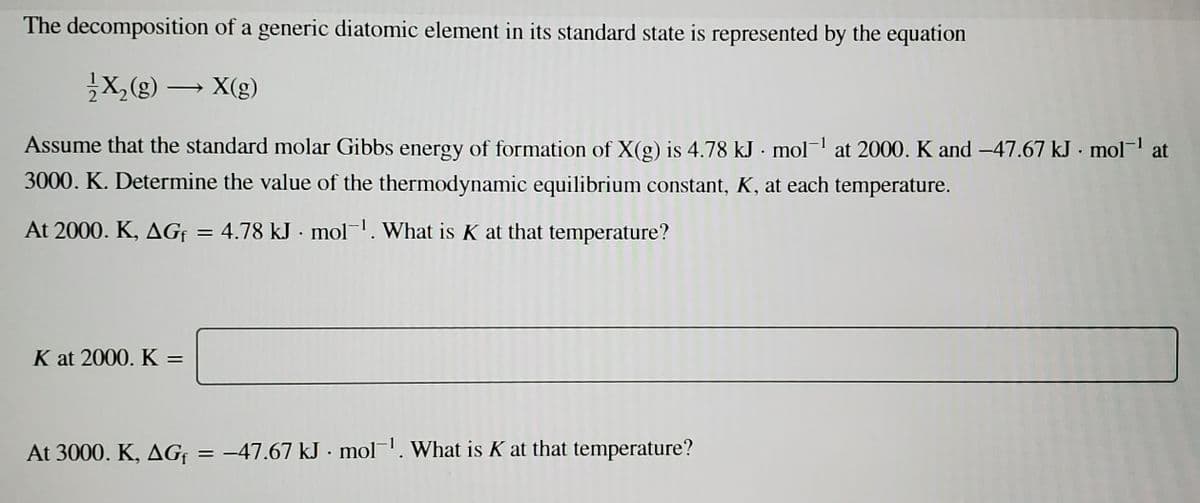The decomposition of a generic diatomic element in its standard state is represented by the equation X,(g) – X(g) Assume that the standard molar Gibbs energy of formation of X(g) is 4.78 kJ mol at 2000. K and -47.67 kJ mol- at 3000. K. Determine the value of the thermodynamic equilibrium constant, K, at each temperature. At 2000. K, AG = 4.78 kJ mol. What is K at that temperature?
The decomposition of a generic diatomic element in its standard state is represented by the equation X,(g) – X(g) Assume that the standard molar Gibbs energy of formation of X(g) is 4.78 kJ mol at 2000. K and -47.67 kJ mol- at 3000. K. Determine the value of the thermodynamic equilibrium constant, K, at each temperature. At 2000. K, AG = 4.78 kJ mol. What is K at that temperature?
Physical Chemistry
2nd Edition
ISBN:9781133958437
Author:Ball, David W. (david Warren), BAER, Tomas
Publisher:Ball, David W. (david Warren), BAER, Tomas
Chapter5: Introduction To Chemical Equilibrium
Section: Chapter Questions
Problem 5.49E: 5.49. Consider the following equilibrium:
What is the effect on the equilibrium of each of the...
Related questions
Question
100%

Transcribed Image Text:The decomposition of a generic diatomic element in its standard state is represented by the equation
X,(g) → X(g)
|
Assume that the standard molar Gibbs energy of formation of X(g) is 4.78 kJ - mol-' at 2000. K and -47.67 kJ · mol-1 at
3000. K. Determine the value of the thermodynamic equilibrium constant, K, at each temperature.
At 2000. K, AGf = 4.78 kJ · mol-. What is K at that temperature?
K at 2000. K =
At 3000. K, AGF
= -47.67 kJ · mol-. What is K at that temperature?

Transcribed Image Text:K at 2000. K =
%3D
At 3000. K, AG =
= -47.67 kJ · mol. What is K at that temperature?
K at 3000. K =
Expert Solution
This question has been solved!
Explore an expertly crafted, step-by-step solution for a thorough understanding of key concepts.
This is a popular solution!
Trending now
This is a popular solution!
Step by step
Solved in 2 steps

Knowledge Booster
Learn more about
Need a deep-dive on the concept behind this application? Look no further. Learn more about this topic, chemistry and related others by exploring similar questions and additional content below.Recommended textbooks for you

Physical Chemistry
Chemistry
ISBN:
9781133958437
Author:
Ball, David W. (david Warren), BAER, Tomas
Publisher:
Wadsworth Cengage Learning,

Chemistry: The Molecular Science
Chemistry
ISBN:
9781285199047
Author:
John W. Moore, Conrad L. Stanitski
Publisher:
Cengage Learning

Principles of Modern Chemistry
Chemistry
ISBN:
9781305079113
Author:
David W. Oxtoby, H. Pat Gillis, Laurie J. Butler
Publisher:
Cengage Learning

Physical Chemistry
Chemistry
ISBN:
9781133958437
Author:
Ball, David W. (david Warren), BAER, Tomas
Publisher:
Wadsworth Cengage Learning,

Chemistry: The Molecular Science
Chemistry
ISBN:
9781285199047
Author:
John W. Moore, Conrad L. Stanitski
Publisher:
Cengage Learning

Principles of Modern Chemistry
Chemistry
ISBN:
9781305079113
Author:
David W. Oxtoby, H. Pat Gillis, Laurie J. Butler
Publisher:
Cengage Learning

Chemistry: Principles and Practice
Chemistry
ISBN:
9780534420123
Author:
Daniel L. Reger, Scott R. Goode, David W. Ball, Edward Mercer
Publisher:
Cengage Learning

Chemistry: Principles and Reactions
Chemistry
ISBN:
9781305079373
Author:
William L. Masterton, Cecile N. Hurley
Publisher:
Cengage Learning

Living By Chemistry: First Edition Textbook
Chemistry
ISBN:
9781559539418
Author:
Angelica Stacy
Publisher:
MAC HIGHER